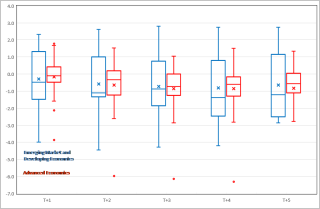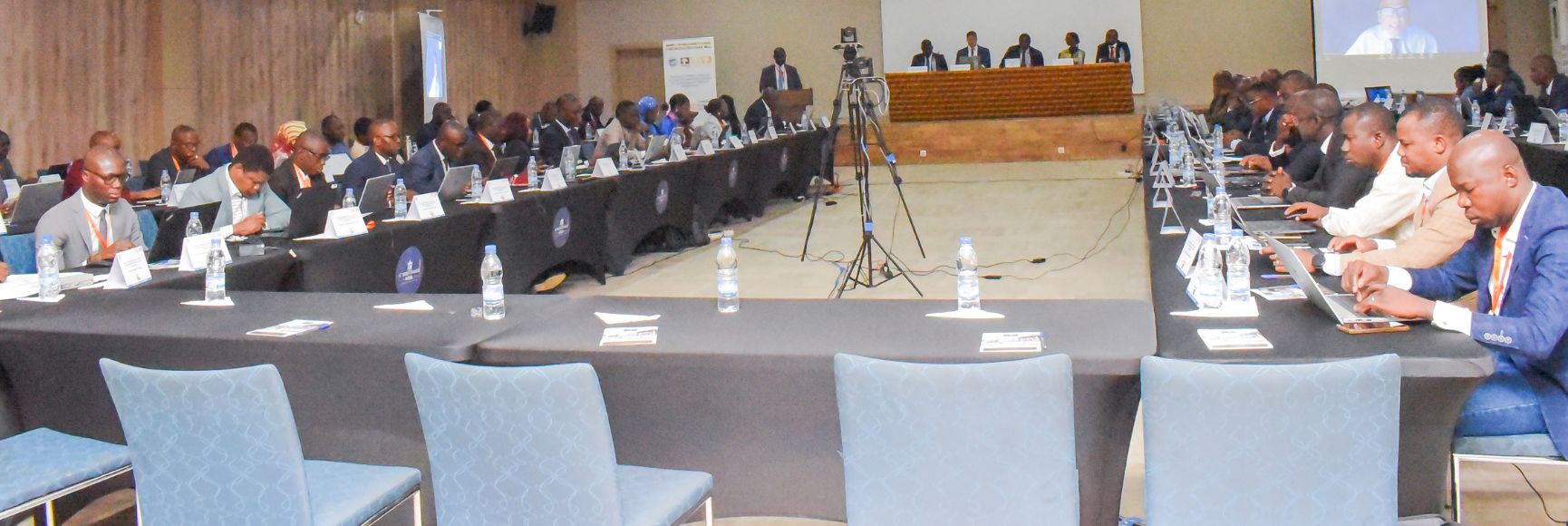Posted by Sybi Hida[1]
Macro-fiscal forecasting in Southern African countries mimics the experience of other developing countries. Forecasting remains a challenge, especially in commodity exporting countries. The main weaknesses relate to the lack of good data and human capacity. Many Southern African countries have invested heavily in building macro-fiscal models—with the support of external experts—and setting up macro-forecasting units. In many cases, the models are complicated and require detailed data that are usually not timely, are unavailable, or do not provide a reliable guide to developments in the real economy. Another constraint is the generally high turnover of staff in forecasting units, as well as the difficulties of operating complex and cumbersome forecasting models.
The chart below, which uses data from the IMF’s World Economic Outlook (WEO)[2], illustrates this point. It shows the errors in forecasting the growth in real GDP for developing economies, emerging markets, and advanced economies from between one year and up to five years ahead. In all cases, the forecast errors in developing and emerging economies are larger and more dispersed than those in advanced economies. This may reflect both these countries’ economic and fiscal vulnerability, as well as unreliable and untimely data.
World Economic Outlook: GDP Growth Forecast Errors, 1995 – 2016
(in percentage)
 Note: The chart shows the minimum and maximum forecast errors, outliers, average (marked as x), median (line within bars), and interquartile range (empty bars) for forecast errors of GDP growth, calculated as the difference between the outturns and the annual WEO projections. Negative forecast errors show an overestimation of GDP growth (i.e., outturns are less than projections).
Note: The chart shows the minimum and maximum forecast errors, outliers, average (marked as x), median (line within bars), and interquartile range (empty bars) for forecast errors of GDP growth, calculated as the difference between the outturns and the annual WEO projections. Negative forecast errors show an overestimation of GDP growth (i.e., outturns are less than projections).
A key message is that investing in sophisticated forecasting models is unlikely to be productive for governments in developing economies, if the aim is to improve the accuracy of their point forecasts. Instead, the aim should be to consider a range of scenarios for the future, and be prepared to use this information to guide fiscal policy.
Preparing a range of scenarios
- Many countries have shifted their focus from point forecasts to forecasting a range of scenarios. For example, in its medium-term budget and strategy outlook, the government of Seychelles presents different scenarios of GDP growth and government revenues from various shocks—tourist arrivals, the exchange rate, and inflation. Namibia and Zimbabwe started last year, with the support of the IMF, to produce different GDP growth scenarios and their impact on debt levels.
How can this be done? Economists working in macro-fiscal units need to spend more time in understanding current economic developments, by collecting data that have a high correlation with the real economy (leading indicators), and by talking and exchanging views with officials from national statistics offices, revenue administrations, central banks, and the business community. Some countries, for example, Mauritius and Namibia, opt for joint working groups led by the ministry of finance to discuss major private sector initiatives, and how these will affect the economy.
Second, admire and learn from complicated models, but use simple ones. Remember your research studies in university, but use those models that work in current circumstances and provide information that can explain your projections. Using simple models would allow macro-forecasting units to produce different scenarios for the future, and move away from the obsession of preparing accurate central-point forecasts. Developing a better understanding of the structure of the major taxes and government expenditures, and their economic impact, is also important.
Be prepared to face up to these scenarios
Once you have a range of scenarios, you need to be prepared to face up to the worse ones, and use the information constructively to guide the government’s fiscal policy stance. A recent IMF Policy Paper[3] shows that countries can face various shocks at the same time, and they are often caught unprepared. A useful starting point is to identify the sources and magnitude of these shocks. Then, prepare for them by following sound budgetary practices. This requires prudent and unbiased fiscal forecasts. Allowing for an explicit budgetary margin to be used for contingencies has also proved to be an effective tool in dealing with the unexpected.
The challenge of forecasting is not only an issue for the public sector. In November 2001 the Chairman of Oaktre Capital, Mr. Howard Marks, wrote a memo to his clients entitled “You can’t predict. You can prepare.”
[1] Sybi Hida is the Macro-Fiscal Resident Advisor at the IMF’s Regional Technical Assistance Center for Southern Africa – AFRITAC South – which covers 13 countries in the region, namely Angola, Botswana, Comoros, Lesotho, Madagascar, Mauritius, Mozambique, Namibia, Seychelles, South Africa, Swaziland, Zambia, and Zimbabwe.
[2] http://www.imf.org/external/pubs/ft/weo/2017/01/weodata/download.aspx
[3] International Monetary Fund. 2016. “Analyzing and Managing Fiscal Risks-Best Practices.” Fiscal Affairs Department Policy Paper, Washington.
Note: The posts on the IMF PFM Blog should not be reported as representing the views of the IMF. The views expressed are those of the authors and do not necessarily represent those of the IMF or IMF policy.






